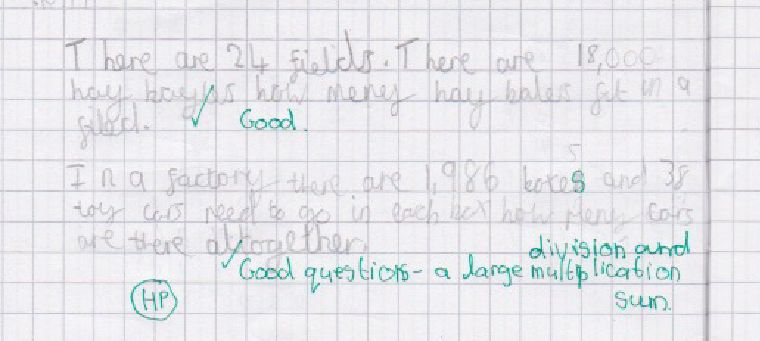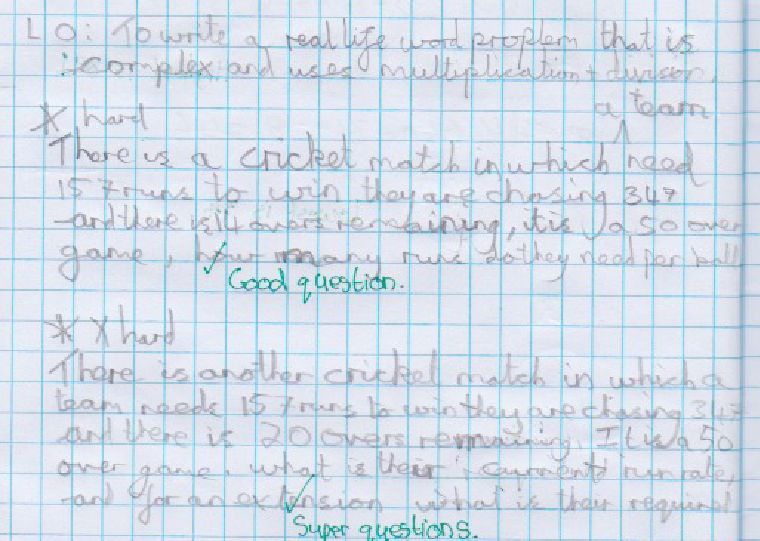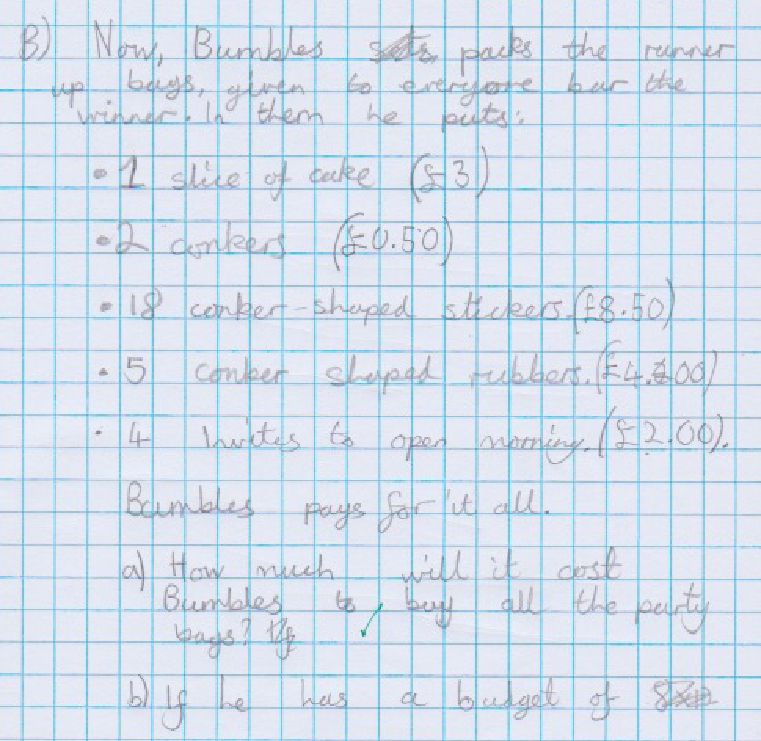How creative journaling supports formative assessment
Batman and Robin, Ant and Dec, and now another perfect pair. Find out why formative assessment and creative journaling go so well together.
Formative assessment is a big part of my daily maths lessons. It helps me delve deep into what learners know so I can adjust my teaching to support them in the best way.
Supporting formative assessment can be done in a few different ways. Sharing learning intentions, setting success criteria, and providing feedback all positively contribute to effective classroom assessment. Using maths journals in lessons also supports formative assessment — provided you choose the right activity and type of journaling.
Creative journaling encourages learners to develop models and stories. They’re a great way for learners to show the full range of their understanding. So, how do you get started with using creative journals to support formative assessment?
Creative journaling: make up your own word problems
Creative journals are a safe place to explore misunderstandings, or stretch more advanced learners who have mastered a concept. Getting the most out of a creative journaling activity starts with choosing a topic that lends itself to a wide range of real-world contexts.
With my Year 6 class, I chose a chapter on the ‘four operations’ and asked the children to make up their own word problems. I intentionally set the activity towards the end of the chapter so the children could show what they could do, and added some rules:
- The word problem can be either a multiplication problem, a division problem, or a multi-step problem that involves both.
- Numbers can be within ‘times table range’ or can be more complex (the previous chapter was numbers to 10 million).
- Problems should aim to be realistic or creative.
- Decide on the level of challenge depending on how you have already negotiated the series of lessons throughout the course of the chapter (6A, Chapter 2).
- Problems have to be written but not solved — that’s for later.
Most learners went for straightforward questions. At this stage, the multiplication questions involving long multiplication and division questions sometimes stayed in ‘times tables range’. More confident pupils used larger numbers.
The journal entries that my class produced showed the delightful variation in learners’ understanding. Let’s look at some creative journaling examples to see how six different learners understood the lesson.
Learner #1: Consolidate understanding
Creative journaling is a great way for learners to consolidate their understanding and show that they’ve grasped the learning intention.

There are 24 fields. There are 18,000 hay bales. How many hay bales fit in a field?
In a factory there are 1,986 boxes and 38 toy cars ready to go in each box. How many cars are there altogether?
This creative journaling example is typical of most of the class — the word problem is straightforward (once we discussed that the hay bales are shared equally) and the route to the answer is easy to find. Here, larger numbers are used for both problems and the different contexts of the word problems worked well.
Learner #2: Learn from mistakes
Journals are a great place to learn from your mistakes. This child’s creative journaling example proved to be a great discussion point for the class.

There are 10,241 cats and 862 cages. They are divided equally into the cages. How many cats in each cage? There are 16 more cats put in each cage, How many cats are there?
By specifying that the cats must be shared equally into the 862 cages, the number of cats must be a factor of 862. The learner hadn’t realised this. Nevertheless, it was a good try. They knew it wasn’t quite right but they were happy to share their thinking with the class.
As a class, we altered the question to ‘how many cages would have 1 cat, how many have 2 cats and how many have 3 cats’? This showed how the question, with only a minor tweak could still work. As for the second part: putting an extra 16 cats together in a cage — my learners decided that probably wasn’t a good idea!
Learner #3: Go beyond a modelled example
Creative journaling is an open task. It gives learners the chance to go beyond the examples they’ve seen modelled in the lesson.

A farmer has 200 apples and packs them in boxes of 15. Each box costs £10. Steve buys 8 boxes then he packs in boxes of 5 and sell them for £7 each. How much money did he make?
Here, the learner built upon the concepts in the latter part of the chapter to design a complex word problem involving multiple operations, including multiplication and division. Using the creative journaling example, we investigated the profit margin as a class and discussed whether it was worth it.
Learner #4: Push the creative limits
Some learners will use journaling as a chance to get creative by linking the maths they’re learning to real-life contexts that mean something to them.

There is a cricket match in which a team needs 157 runs to win. They are chasing 347 and there are 14 overs remaining, it is a 50 over game. How many runs do they need per ball? There is another cricket match in which a team needs 157 runs to win. They are chasing 347 and there is 20 overs remaining. It is a 50 over game. What is their current run rate?
Just like Learner #3, this child’s problem involves multiple operations. They took it a step further by setting it within the rules of cricket. The question’s flexibility is also wide — he chose to keep the numbers the same but varied the number of overs played. In the first question, having multiplied 14 by 6, learners then discussed what running 1.86 runs actually meant.
Learner #5: Be ambitious
There’s no limit to how far a learner can take a creative journaling assignment, so expect a few learners to be ambitious.

Now, Bumbles packs the runner up bags, given to everyone bar the winner. In them he puts:
• 1 slice of cake (£3)
• 2 conkers (£0.50)
• 18 conker shapes stickers (£8.50)
• 5 conker shapes rubbers (£4.00)
• 4 invites to open morning (£2.00)
Bumbles pays for it all.
How much will it costs Bumbles to buy all the party bags?
This was the second part of a question that involved a large school, in the thousands, that took part in a conker competition. Having found the total amount of participants, everyone was then awarded with a goody bag. Having worked out the total cost, the extension was to find out the total amount of ‘actual things’ needed to fill all the bags.
Learner #6: Full of surprises
Journaling is low stakes, it’s not a test, just a chance for learners to show you what they know. This takes a lot of pressure off and helps learners take risks with their entries — so expect some surprises.

Gareth was playing rugby he scores 5 tries in the first half and 5 in the second. Dave scores 2 times a much as Gareth. Bob scores half as much as Dave. How many tries did they score all together?
In this creative journaling example, the learner found mental recall of number bonds tricky, yet, it’s clear he understood the concept. He thought hard about the question and tried to disguise the numbers by referring to double and half the number of tries scored. The sum was actually quite straightforward and it encouraged a productive discussion on how word problems need to be understood first.
Creative journaling shows off your learners’ personalities. They can use their hobbies, interests, and things that are happening at school. Asking learners to set questions for classmates to solve means you get quite a spectrum of difficulty — depending on how much they like their friends! They could also design their problems for you to solve.
The discussions that came from this journaling activity helped pupils reflect on what they had learned and gave them what they needed to make further progress. It was an informal assessment that highlighted the general attitude towards maths and mathematical confidence.
Afterwards, the journal entries were displayed on our class maths wall for visitors to look at and solve, showing how much maths has changed for the better.
